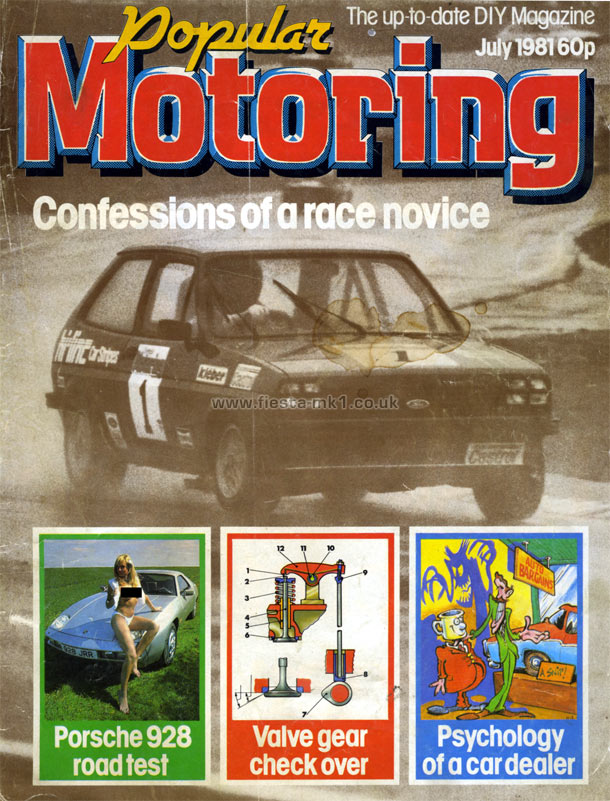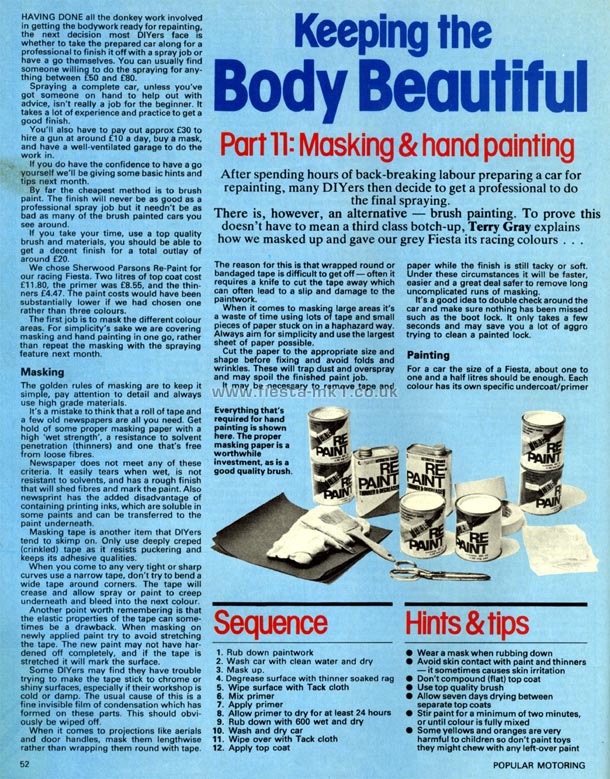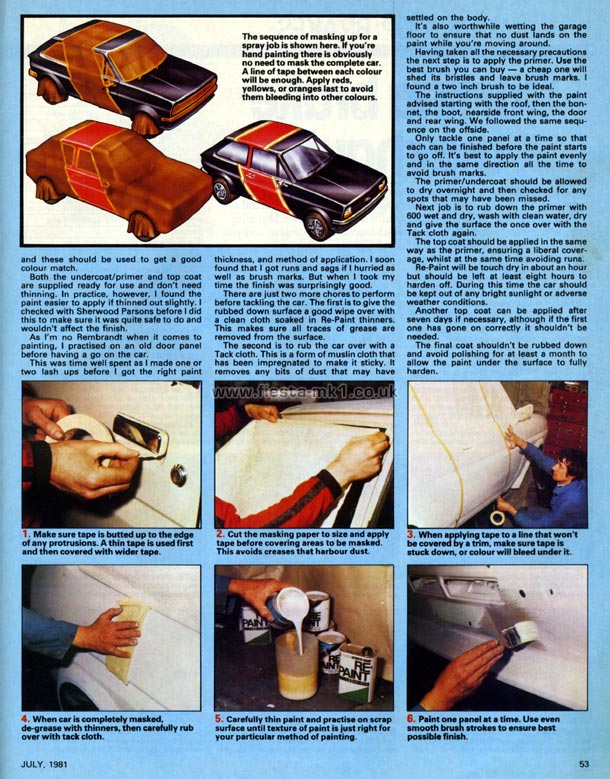Copy of Article Text Below
Keeping the Body Beautiful - Part 11: Masking & hand painting
After spending hours of back-breaking labour preparing a car for repainting, many DIYers then decide to get a professional to do the final spraying. There is, however, an alternative - brush painting. To prove this doesn't have to mean a third class botch-up, Terry Gray explains how we masked up and gave our grey Fiesta its racing colours . . .
HAVING DONE all the donkey work involved in getting the bodywork ready for repainting, the next decision most DIYers face is whether to take the prepared car along for a professional to finish it off with a spray job or have a go themselves. You can usually find someone willing to do the spraying for anything between £50 and £80.
Spraying a complete car, unless you've got someone on hand to help out with advice, isn't really a job for the beginner. It takes a lot of experience and practice to get a good finish.
You'll also have to pay out approx £30 to hire a gun at around £10 a day, buy a mask, and have a well-ventilated garage to do the work in.
If you do have the confidence to have a go yourself we'll be giving some basic hints and tips next month.
By far the cheapest method is to brush paint. The finish will never be as good as a professional spray job but it needn't be as bad as many of the brush painted cars you see around.
If you take your time, use a top quality brush and materials, you should be able to get a decent finish for a total outlay of around £20.
We chose Sherwood Parsons Re-Paint for our racing Fiesta. Two litres of top coat cost £11.80, the primer was £8.55, and the thin-ners £4.47. The paint costs would have been substantially lower if we had chosen one rather than three colours.
The first job is to mask the different colour areas. For simplicity's sake we are covering masking and hand painting in one go, rather than repeat the masking with the spraying feature next month.
Masking
The golden rules of masking are to keep it simple, pay attention to detail and always use high grade materials.
It's a mistake to think that a roll of tape and a few old newspapers are all you need. Get hold of some proper masking paper with a high 'wet strength', a resistance to solvent penetration (thinners) and one that's free from loose fibres.
Newspaper does not meet any of these criteria. It easily tears when wet, is not resistant to solvents, and has a rough finish that will shed fibres and mark the paint. Also newsprint has the added disadvantage of containing printing inks, which are soluble in some paints and can be transferred to the paint underneath.
Masking tape is another item that DIYers tend to skimp on. Only use deeply creped (crinkled) tape as it resists puckering and keeps its adhesive qualities.
When you come to any very tight or sharp curves use a narrow tape, don't try to bend a wide tape around corners. The tape will crease and allow spray or paint to creep underneath and bleed into the next colour.
Another point worth remembering is that the elastic properties of the tape can sometimes be a drawback. When masking on newly applied paint try to avoid stretching the tape. The new paint may not have hardened off completely, and if the tape is stretched it will mark the surface.
Some DIYers may find they have trouble trying to make the tape stick to chrome or shiny surfaces, especially if their workshop is cold or damp. The usual cause of this is a fine invisible film of condensation which has formed on these parts. This should obviously be wiped off.
When it comes to projections like aerials and door handles, mask them lengthwise rather than wrapping them round with tape.
The reason for this is that wrapped round or bandaged tape is difficult to get off - often it requires a knife to cut the tape away which can often lead to a slip and damage to the paintwork. When it comes to masking large areas it's a waste of time using lots of tape and small pieces of paper stuck on in a haphazard way. Always aim for simplicity and use the largest sheet of paper possible.
Cut the paper to the appropriate size and shape before fixing and avoid folds and wrinkles. These will trap dust and overspray and may spoil the finished paint job.
It may be necessary to remove tape and paper while the finish is still tacky or soft. Under these circumstances it will be faster, easier and a great deal safer to remove long uncomplicated runs of masking.
It's a good idea to double check around the car and make sure nothing has been missed such as the boot lock. It only takes a few seconds and may save you a lot of aggro trying to clean a painted lock.
Painting
For a car the size of a Fiesta, about one to one and a half litres should be enough. Each colour has its own specific undercoat/primer.....
Sequence
1. Rub down paintwork
2. Wash car with clean water and dry
3. Mask up
4. Degrease surface with thinner soaked rag
5. Wipe surface with Tack cloth
6. Mix primer
7. Apply primer
8. Allow primer to dry for at least 24 hours
9. Rub down with 600 wet and dry
10. Wash and dry car
11. Wipe over with Tack cloth
12. Apply top coat
Hints &tips
- Wear a mask when rubbing down
- Avoid skin contact with paint and thinners - it sometimes causes skin irritation
- Don't compound (flat) top coat
- Use top quality brush
- Allow seven days drying between separate top coats
- Stir paint for a minimum of two minutes, or until colour is fully mixed
- Some yellows and oranges are very harmful to children so don't paint toys they might chew with any left-over paint
Captions -
Middle - Everything that's required for hand painting is shown here. The proper masking paper is a worthwhile investment, as is a good quality brush.
|


